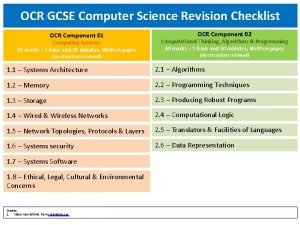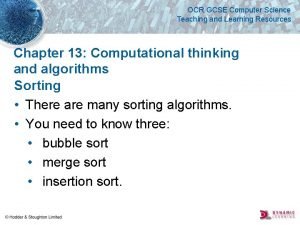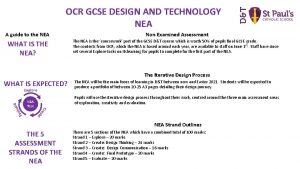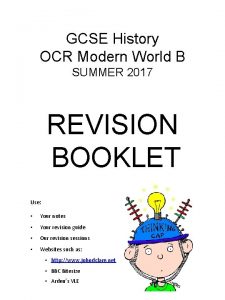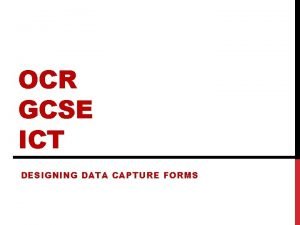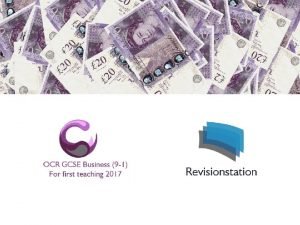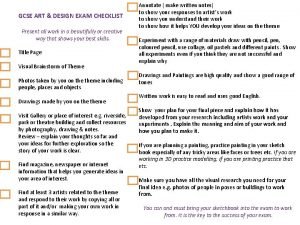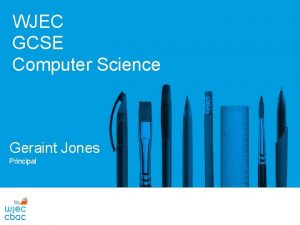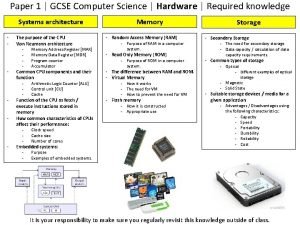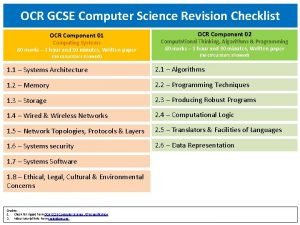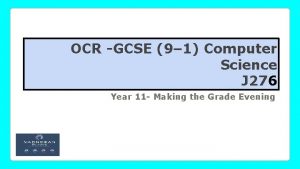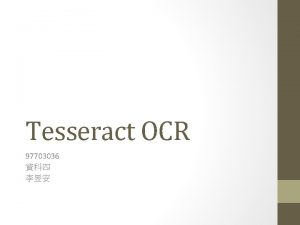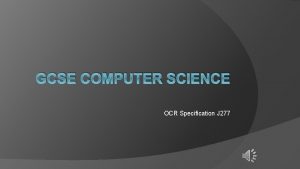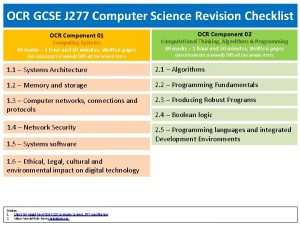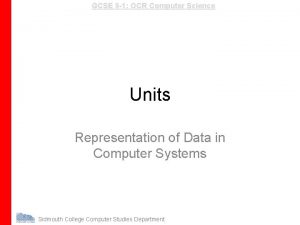OCR GCSE 9 1 Computer Science J 276












- Slides: 12

OCR GCSE (9 -1) Computer Science (J 276) (01) Computer Systems L 2

1. 1 Systems Architecture Recap…. Last lesson, we looked at: • what is a computer system; • defining a computer system; • understanding the architecture of a computer system.

1. 1 Systems Architecture Recap…. – Define a computer system. A Computer System is a combination of hardware and software components that allow input, processing and output of data.

1. 1 Systems Architecture

1. 1 Systems Architecture All computer systems must have input devices that get data from the real-world. This could be a mouse and keyboard on a conventional PC but could be a temperature sensor (thermistor) in a commercial greenhouse or the microphone on a mobile phone. Input devices take real-world data and convert it into a form that can be stored on the computer.

1. 1 Systems Architecture The input from these devices is processed and the computer system will generate outputs. The output device could be a conventional computer screen or it could be a motor that opens a greenhouse window or the speaker that produces sound on a phone.

1. 1 Systems Architecture Learning Objective: 1. 1. 1 Understand the purpose of the CPU; 1. 1. 3 Describe the structure of the CPU; 1. 1. 3 Describe the common components and their function: ALU, CU and Cache.

1. 1. 1 Understand the purpose of the CPU; 1. 1. 3 Describe the structure of the CPU; 1. 1. 3 Describe the common components and their function: ALU, CU and Cache. Keywords: • • • Central Processing Unit (CPU) Von Neumann Architecture MAR (Memory Address Register) MDR (Memory Data Register) ALU (Arithmetic Logic Unit) Accumulator

1. 1. 1 Understand the purpose of the CPU; 1. 1. 3 Describe the structure of the CPU; 1. 1. 3 Describe the common components and their function: ALU, CU and Cache. Recap…. – Define a CPU. It is the part of the computer that controls the interpretation and execution of instruction i. e. it processes the raw data and turns it into information.

1. 1. 1 Understand the purpose of the CPU; 1. 1. 3 Describe the structure of the CPU; 1. 1. 3 Describe the common components and their function: ALU, CU and Cache. The central processing unit (CPU) of a computer is the hardware that executes programs and manages the rest of the hardware. • The “brains” of the computer • Carries out instructions (Executes Instructions) • Processes Data • Retrieves Data/Instructions from Main Memory (Fetch) • Stores Data into Main Memory once Executed

1. 1. 1 Understand the purpose of the CPU; 1. 1. 3 Describe the structure of the CPU; 1. 1. 3 Describe the common components and their function: ALU, CU and Cache. TASK 1 Complete the Systems Architecture CPU worksheet

1. 1. 1 Understand the purpose of the CPU; 1. 1. 3 Describe the structure of the CPU; 1. 1. 3 Describe the common components and their function: ALU, CU and Cache. TASK 2 – What is the purpose of the processor? – Where are instructions that are currently in use stored? – What else is stored in main memory? – How are instructions executed by the processor?
 Worksheet 2 searching algorithms answers
Worksheet 2 searching algorithms answers Ocr computer science checklist
Ocr computer science checklist Ocr computer science resources
Ocr computer science resources Ocr
Ocr Language book
Language book Ocr product design gcse
Ocr product design gcse Ocr gcse business studies past papers
Ocr gcse business studies past papers History gcse spec
History gcse spec Text data capture forms
Text data capture forms Ocr j276/01
Ocr j276/01 Gcse art final piece evaluation template
Gcse art final piece evaluation template Wjec gcse computer science
Wjec gcse computer science Hardware gcse computer science
Hardware gcse computer science

